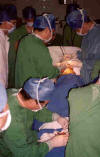1) Heinrich Cheng
(Taiwan)
2) Dr. Shaocheng Zhang
(China)
3) Dr. Carl Kao (Ecuador)
1) Dr.
Heinrich Cheng: In 1996, Dr. Cheng and colleagues
(Stockholm, Sweden) published a widely cited article on functional
regeneration in rat spinal cords after peripheral nerve implantation (Science
273, 1996). Building upon this work, he has since transplanted peripheral
nerve segments and injected a mixture of growth factors into the injury
site of many patients with both acute and chronic SCI. There is
considerable interest in SCI in Taiwan because the country’s “first lady”
sustained a SCI.
Recently, Cheng and colleagues (Tapei, Taiwan)
reported a case study of a patient who sustained an injury from a stabbing
four years previous to surgical intervention (Spine, 29(14), 2004).
Stabbing represents a more unique transection injury compared to the
contusion injury that most patients with SCI have sustained. Specifically,
the lesion at the T11 level was bridged with sural nerve grafts that
redirected specific pathways from white to gray matter. The grafted area
was stabilized with fibrin glue containing fibroblast growth factor.
Two-and-a-half years after surgery, the patient had improved from C to D
on the commonly used ASIA assessment scale.
Over the 2000–2003 period, Cheng has treated 25 cases
with the approach. Of these cases, 10 were cervical injuries of which
seven improved in motor score and sensory scores. He has been authorized
to carry out an additional 115 patients.

2)
Dr. Shaocheng Zhang
(Shanghai, China) has microsurgically implanted peripheral nerve segments
into the injury site of patients with incomplete SCI.
 Specifically,
after the endorachis was opened (outer enveloping layer of the spinal dura
mater), various adhering fibrous bands were removed, and then autologous
(i.e., from the patient), sural-nerve segments were implanted in shallow
incisions that had been made slightly longer than the area of abnormality.
Before implantation, the segments had been stripped of their covering
connective tissue, making them resemble cauda equine tissue. The 35
patients studied included 30 males and 5 females; ranged in age from 16 to
42 years; and had sustained their injuries 6 to 26 months (average 13)
before surgery. Ten, 19 and 6 were injured in T7-9, T10-12, and L1-2
regions, respectively Thirty-two regained some ambulatory function (Photo:
Zhang's surgical team).
Specifically,
after the endorachis was opened (outer enveloping layer of the spinal dura
mater), various adhering fibrous bands were removed, and then autologous
(i.e., from the patient), sural-nerve segments were implanted in shallow
incisions that had been made slightly longer than the area of abnormality.
Before implantation, the segments had been stripped of their covering
connective tissue, making them resemble cauda equine tissue. The 35
patients studied included 30 males and 5 females; ranged in age from 16 to
42 years; and had sustained their injuries 6 to 26 months (average 13)
before surgery. Ten, 19 and 6 were injured in T7-9, T10-12, and L1-2
regions, respectively Thirty-two regained some ambulatory function (Photo:
Zhang's surgical team).

3) Dr.
Carl Kao (Quito, Ecuador) is considered one of
the more controversial neurosurgeons over the past 30 years but perhaps
was actually a head of his times. Building upon his early research in
spinal-cord injured dogs carried out at George Washington University
(Washington, DC), he started transplanting peripheral nerve segments into
the injury site of humans with SCI, and, reportedly, has since treated 600
with SCI. He specifically transplants sural nerve segments from the leg
into the injury site and surgically covers the area with an unattached
piece of omentum reconnecting this tissue with a
surrounding vascular source (see below for discussion). To enhance graft
survival, patients are treated for several weeks with hyperbaric oxygen
and later with the conduction-promoting drug
4-aminopyridine.
TOP